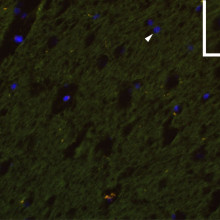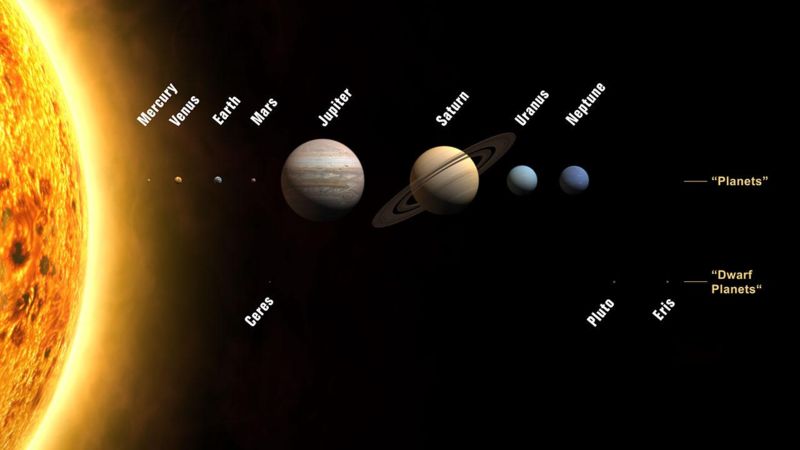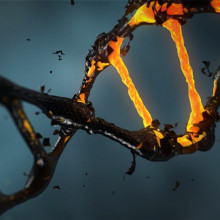In this NewsFlash, we hear why Eunuchs live longer lives and how a laundry detergent additive could convert clothes into pollution busting air filters. Plus, finding foetal DNA in a mother's brain and the neurological basis for positive bias.
In this episode

03:39 - Catalytic Clothing Cleans Polluted Air
Catalytic Clothing Cleans Polluted Air
Professor Tony Ryan, University of Sheffield
Ben - Laundry detergent containing a special additive could convert clothes into pollution-busting air filters according to research funded by the EPSRC. The additive called CatClo stems from a collaboration between the University of Sheffield and the London College of Fashion. It's based on using nanoparticles of titanium dioxide to catalyse reactions that then break down the pollutants. Professor Tony Ryan, Pro-Vice Chancellor for the Faculty of Science at the University of Sheffield explained how the idea came about.
 Tony - The problem was posed by a teenage girl and the teenage girl asked me a question about, "Can we use ambient energy to do environmental clean-up?" And it made me think about using the temperature difference between your body and the air, and there wasn't much there, and it just led me to photocatalysis. So, I realised that people are wandering around in the light, can we make light drive a reaction that does some environmental clean-up?
Tony - The problem was posed by a teenage girl and the teenage girl asked me a question about, "Can we use ambient energy to do environmental clean-up?" And it made me think about using the temperature difference between your body and the air, and there wasn't much there, and it just led me to photocatalysis. So, I realised that people are wandering around in the light, can we make light drive a reaction that does some environmental clean-up?
Ben - Titanium dioxide is also known as titania and is widely used as a white pigment in products as varied as paints and paper, through to foods, tablets, and even toothpaste. But it's another property, the ability to catalyse reactions in the presence of light that allows it to purge pollution.
Tony - The nano-titania has a very high surface area per unit mass. The reaction takes place on the surface. A photon comes in and excites an electron in the titania, that then reacts with oxygen to split oxygen into free radicals. Those free radicals react with water to make peroxide which is bleach and then that bleach oxidises things and it oxidises whatever it comes in contact with. Because it's in the gas phase, the things that get oxidised first and foremost are in the gas phase and so, they will be volatile organics, your smell, and any airborne pollutant. If you're in an urban environment then the concentration of nitric oxide is such that it will take out some of the nitric oxide.
Ben - Photocatalysis is not a new concept. Similar chemistry also using titanium dioxide is involved in self-cleaning glass.
Tony - The breakthrough, if there was a breakthrough was the realisation that the surface of a piece of self-cleaning glass is basically the length of the square of glass squared. Whereas your clothes, the surface area of your clothes is the surface area of all of the fibres, so it's much, much bigger than the area of the fabric if you were to unfold all the fibres. My suit has an active surface area of getting on for 60 square metres. Clothing tends to be at the level where you want to eradicate the pollution. You take advantage of the temperature gradient inside and out because that gives you a net flux of air and the environmental clean-up agent is perambulating. Even if you have an architectural surface covered with paint that is designed to take out air pollution, you still need the wind and not wanting to make a pun, people make their own wind.
Ben - But how much difference could catalytic trousers really make?
Tony - A pair of catalysed jeans will take out somewhere between a gram and 2 grams of nitric oxide out of the atmosphere a day. If enough people do that, the numbers build up very, very quickly. So for example, if half of the population of Sheffield were wearing catalysed jeans, we'd be able to bring Sheffield from exceeding the safe limit of nitric oxide which is 40 milligrams per cubic metre, and currently, we exceed it by about 10%, and it would be able to bring us below that value for the whole of the year in the city.
Ben - So, a fully catalysed person could make a minor difference, but reaching enough people requires a new approach.
Tony - In order for this to work, it has to be universal because the amount that any one person takes out is rather small. So, to take out the nitric oxide pollution from a single car needs about 5 people to be catalysed. So, what you need to do then is make sure that as many people as possible in a city are catalysed and rather than dealing with a brand of clothing, it's much easier to deal with something that everybody does which is wash their clothes. What we're trying to do is get laundry manufacturers to come together to deliver this technology via the laundry.
Ben - Of course, anything added to laundry detergent is going to end up in the sewers, so one concern is the potential to change the chemistry in sewers and in water treatment plants.
Tony - Sewers is really easy because it's dark in a sewer and the catalyst only works when it sees light. So if a piece of titanium dioxide sees light then it's a photocatalyst. If a piece of titanium dioxide is in the dark, it's a lump of rock. Likewise in the sewage front, 2 millimetres of water is enough to filter out a big proportion of the UV and then the question is, what do titanium nanoparticles do to the bugs in the sewage plant? And that's absolutely something we're looking at.
Ben - The researchers are now working closely with a manufacturer of environmentally friendly cleaning products to commercialise CatClo and they hope to have something in the market within a couple of years. They hope that as well as the wider environmental clean-up, these additives will benefit people suffering from asthma and respiratory problems. And Professor Ryan also highlights one other less obvious benefit.
Tony - And for Yorkshire man like me, the best thing is it's a license to fart.

09:39 - Foetal DNA in Mum's Brain
Foetal DNA in Mum's Brain
Male DNA, almost certainly left over from a male foetus, has been found lurking in women's brains, according to research published in PLoS ONE this week. It's unclear what effect this may have on maternal health.
Foetal Microchimerism is the process by which foetal cells and DNA can escape the womb and get into the tissues and blood stream of a pregnant woman, but this work, carried out by William Chan of Fred Hutchinson Cancer Research Center and his colleagues, is the first to show that these cells can reach and persist in her brain.
The team looked at brain samples taken from the autopsies of 59 women and tested for the presence of Y chromosome DNA, which can only have come from a male. 63% of their samples were positive for male DNA, showing not just that it's very common, but also that it's very long lasting - the oldest female positive for male DNA was 94 years old.
Generally, the blood brain barrier should keep foreign cells like these out, but changes during pregnancy can cause the barrier to become more porous, giving chimeric cells a window of opportunity.
This is a small study, so any potential effect on maternal health is unclear. Foetal microchimerism has previously been shown to be a double edged sword. These cells may aid tissue repair and protect against breast cancer, but may also increase the risk of autoimmune diseases and other cancers.
Women who have had more children also seem to be at greater risk of developing Alzheimer's disease, so the researchers were very surprised to see that women with Alzheimer's had a lower prevalence of male cells in the brain and in particular in brain regions most affected by the disease. This finding raises more questions than it answers, but does suggest that microchimerism may have some protective effect on the brain.

11:58 - The bright-side bias
The bright-side bias
The brain basis of the human tendency to always look on the bright side has been revealed by new research.Scientists have known for some time that volunteers will take on board new information that has a positive message much more readily than negative information, which they tend to ignore.  Some speculate that this "good news / bad news effect", as it's known, might underlie financial bubbles, and psychologists also suspect that it accounts for natural optimism, over-confidence and poor judgements made during critical medical or health situations.The reason for this has been a mystery. But now, UCL scientist Ray Dolan and his colleagues have used a technique called TMS -that's transcranial magnetic stimulation - to temporarily deactivate a brain region called the inferior frontal gyrus (IFG), making the effect disappear.The inferior frontal gyrus has previously been linked to self-inhibition and also to updating what we believe about ourselves and the world around us. Publishing in PNAS this week, the UCL team asked a group of volunteers to estimate the likelihoods of their suffering 40 different adverse events ranging from developing Alzheimer's to being robbed. The subjects were then presented with data showing the true frequency of each event in their representative populations. While they were reviewing this data, TMS was applied to the subjects' brains to switch off either their right or left inferior frontal gyrus, or an unrelated "control" part of the brain. They were then asked to re-estimate their risks for each of the adverse life events they had considered previously.The researchers found that inhibiting the right IFG, or a control brain region, had no effect. Just as before, the subjects revised their estimations in response to good news - when they found out they were less likely to suffer one of these events than they had thought - but they buried the bad news. Inhibiting the left IFG, though, produced a radical rethink on the part of the subjects, with 60% of them ceasing to ignore the bad news as they had done before.( Examining the data confirmed that the effect wasn't because subjects were less good than they had been previously at incorporating good news, rather their ability to take on board the bad had improved. )As the researchers point out in their paper, there are positive benefits to regarding the metaphorical glass as half full rather than half empty, because emphasising the pros and ignoring the cons "increases exploratory behaviour and reduces stress and anxiety, a factor that has links with physical and mental well-being..."In other words, it has probably evolved to help us to avoid depression and anxiety, and so be better able to function in the world...
Some speculate that this "good news / bad news effect", as it's known, might underlie financial bubbles, and psychologists also suspect that it accounts for natural optimism, over-confidence and poor judgements made during critical medical or health situations.The reason for this has been a mystery. But now, UCL scientist Ray Dolan and his colleagues have used a technique called TMS -that's transcranial magnetic stimulation - to temporarily deactivate a brain region called the inferior frontal gyrus (IFG), making the effect disappear.The inferior frontal gyrus has previously been linked to self-inhibition and also to updating what we believe about ourselves and the world around us. Publishing in PNAS this week, the UCL team asked a group of volunteers to estimate the likelihoods of their suffering 40 different adverse events ranging from developing Alzheimer's to being robbed. The subjects were then presented with data showing the true frequency of each event in their representative populations. While they were reviewing this data, TMS was applied to the subjects' brains to switch off either their right or left inferior frontal gyrus, or an unrelated "control" part of the brain. They were then asked to re-estimate their risks for each of the adverse life events they had considered previously.The researchers found that inhibiting the right IFG, or a control brain region, had no effect. Just as before, the subjects revised their estimations in response to good news - when they found out they were less likely to suffer one of these events than they had thought - but they buried the bad news. Inhibiting the left IFG, though, produced a radical rethink on the part of the subjects, with 60% of them ceasing to ignore the bad news as they had done before.( Examining the data confirmed that the effect wasn't because subjects were less good than they had been previously at incorporating good news, rather their ability to take on board the bad had improved. )As the researchers point out in their paper, there are positive benefits to regarding the metaphorical glass as half full rather than half empty, because emphasising the pros and ignoring the cons "increases exploratory behaviour and reduces stress and anxiety, a factor that has links with physical and mental well-being..."In other words, it has probably evolved to help us to avoid depression and anxiety, and so be better able to function in the world...

15:32 - Pulsars, Puddles and Proto-Planetary Discs
Pulsars, Puddles and Proto-Planetary Discs
This week has seen planetary scientists gathering in Madrid for the European Planetary Science Congress, and several exciting new findings have been reported.
Sun-shocks Shape Solar System
A series of stellar shockwaves seem to have been responsible for shaping our solar system.
 There are still a number of unanswered questions as to how our solar system actually formed, but a new model of activity in the newly formed Sun may help to explain why our planets formed where they did, and why.
There are still a number of unanswered questions as to how our solar system actually formed, but a new model of activity in the newly formed Sun may help to explain why our planets formed where they did, and why.
Dr Tagir Abdylmyanov, Associate Professor from Kazan State Power Engineering University modelled the clouds of gas from which the Sun formed, and hypothesises that a series of shockwaves would have sent ripples into the material. These rings of increased density would then go on to accrete and form the planets and asteroid belt. He argues that the planets would have formed in stages as solar activity changed, and that we should now be on the lookout for stellar shockwaves in star forming regions.
How did Vesta get its Water?
Data from NASA's Dawn mission, which studied the asteroid Vesta, suggest that we need to rethink our ideas of how the Earth got to be such a watery planet.
Using Dawn's Visible and Infrared Mapping Spectrometer, a team led by Maria Cristina De Sanctis of the Institute of Astrophysics and Space Planetology in Rome, showed that concentration of hydroxyl - a hydrogen and an oxygen atom bound together - was uneven, and not at all like the distribution found on the Moon.
On the Moon these water precursors are thought to be caused by the interaction of the solar wind with the lunar rock, while most of the hydroxyls on Vesta appear to have been delivered not by a continual drip-feed process, but by a rain of small particles of primitive, dusty material. This may have taken place at the solar system's formation, or during a fantastically violent time known as the late heavy bombardment.
The situation on Vesta is unlikely to be unique, so this result clearly tells us that a number of methods are responsible for delivering water around the solar system.
Pulsar Planets
Pulsars are very extreme stars; they're made up of the core that is left over after a supernova and spin rapidly, beaming radiation like a lighthouse. So it may seem very strange that at least two of them have been found to have their own planetary systems.
New research by Fabrice Mottez of the Paris Observatory may help us to find more of these, and to understand the conditions on these very strange planets. He says:
This electro-magnetic wake could be visible to us here on Earth, helping to spot more circumpulsar planets, but would also disturb supernova debris, as well as small bodies such as nearby asteroids and comets, helping to explain how these exotic systems can form.

18:44 - Long Lived Eunuchs and DNA in Mum's Brain
Long Lived Eunuchs and DNA in Mum's Brain
In this NewsFlash, we hear why Eunuchs live longer lives and how a laundry detergent additive could convert clothes into pollution busting air filters. Plus, finding foetal DNA in a mother's brain and the neurological basis for positive bias.










Comments
Add a comment